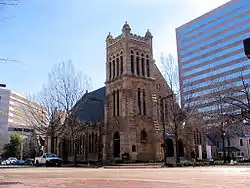Cathedral Church of the Advent (Birmingham, Alabama)
The Cathedral Church of the Advent in Birmingham, Alabama, is the see church of the Episcopal Diocese of Alabama. On March 30, 1983, the structure was added to the National Register of Historic Places as the Episcopal Church of the Advent.
Episcopal Church of the Advent | |
 The church in 2006 | |
| Location | 2017 6th Avenue North (at 20th Street) Birmingham, Alabama |
|---|---|
| Coordinates | 33°31′9″N 86°48′30″W |
| Built | 1883 |
| Architect | Charles Wheelock |
| Architectural style | Gothic |
| NRHP reference No. | 83002972 [1] |
| Added to NRHP | March 30, 1983 |
- For other places of worship named Advent, see Church of the Advent (disambiguation).
History
The parish church of the Advent was established in 1872, one year after the founding of the city of Birmingham, and was one of the first churches built in the new city. The first building on this site was completed in 1873, but was destroyed by fire on November 24, 1892. The current structure was already underway at that date. It was designed by Wheelock, Joy, and Wheelock, was occupied in the fall of 1893, with the tower and portico undergoing construction until 1895. The cathedral is known for its prominent location on Twentieth Street North near Linn Park, as well as for the reputation of its music program. It was not until 1982 that the Church of the Advent became a cathedral, when the Diocese of Alabama selected the church as its seat.[2]
Today
The congregation undertook a major project to preserve the Scioto sandstone exterior of the Cathedral between 1999 and 2005. During this same period the Rector's Garden was redesigned to improve drainage and accommodate a columbarium and the belltower was refitted for a carillon of fifteen bells, cast by Fonderie Paccard of Lac d'Annecy, France. In both 2005 and 2012, readers of the Birmingham News named the cathedral choir "Best Church Choir". Today, the Church of the Advent comprises nearly 4,000 members, making it one of the ten largest Episcopal churches in the United States.[2] The current Dean of the Cathedral is the Very Reverend Andrew C. Pearson, Jr.[3] The cathedral campus is also home to the Advent Episcopal Day School.[4] Carpenter House, the headquarters building for the Diocese of Alabama, is connected to the cathedral building by a cloister.
While, on the whole, the Episcopal Church has, by the departure of its most strident conservatives for the Continuing Anglican or Anglican realignment, become a predominantly liberal denomination, the Cathedral has developed, especially over the past 30 years, a strong commitment to traditional theology and ethics, especially emphasizing the evangelical (or Low Church) wing of Anglicanism. It has been strongly critical of the denomination's increased acceptance of homosexuality as a permissible Christian lifestyle and dominance by Broad Church interpretations of the faith, with Advent instead emphasizing the English Reformation as its founding principle for preaching, teaching, and mission. As such, Advent has frequently found itself in tension with its own diocese and some of its neighboring Birmingham-area parishes (some of whom were in fact "daughter" churches of the Cathedral, back when it was simply a parish, in the 19th and 20th centuries), which are generally supportive of the general national stances on theology and ethics. One of the largest parishes in the entire denomination, Advent has become a leader among those conservative churches still affiliated with ECUSA.
See also
References
- "National Register Information System". National Register of Historic Places. National Park Service. January 23, 2007.
- "Our Parish: History". Cathedral Church of the Advent. Archived from the original on 2013-11-12. Retrieved 2014-02-25.
- "Our Clergy". Cathedral Church of the Advent. Retrieved 2014-02-25.
- "Advent At A Glance". Advent Episcopal School. Retrieved 2014-02-25.
External links
| Wikimedia Commons has media related to Cathedral Church of the Advent (Birmingham, Alabama). |